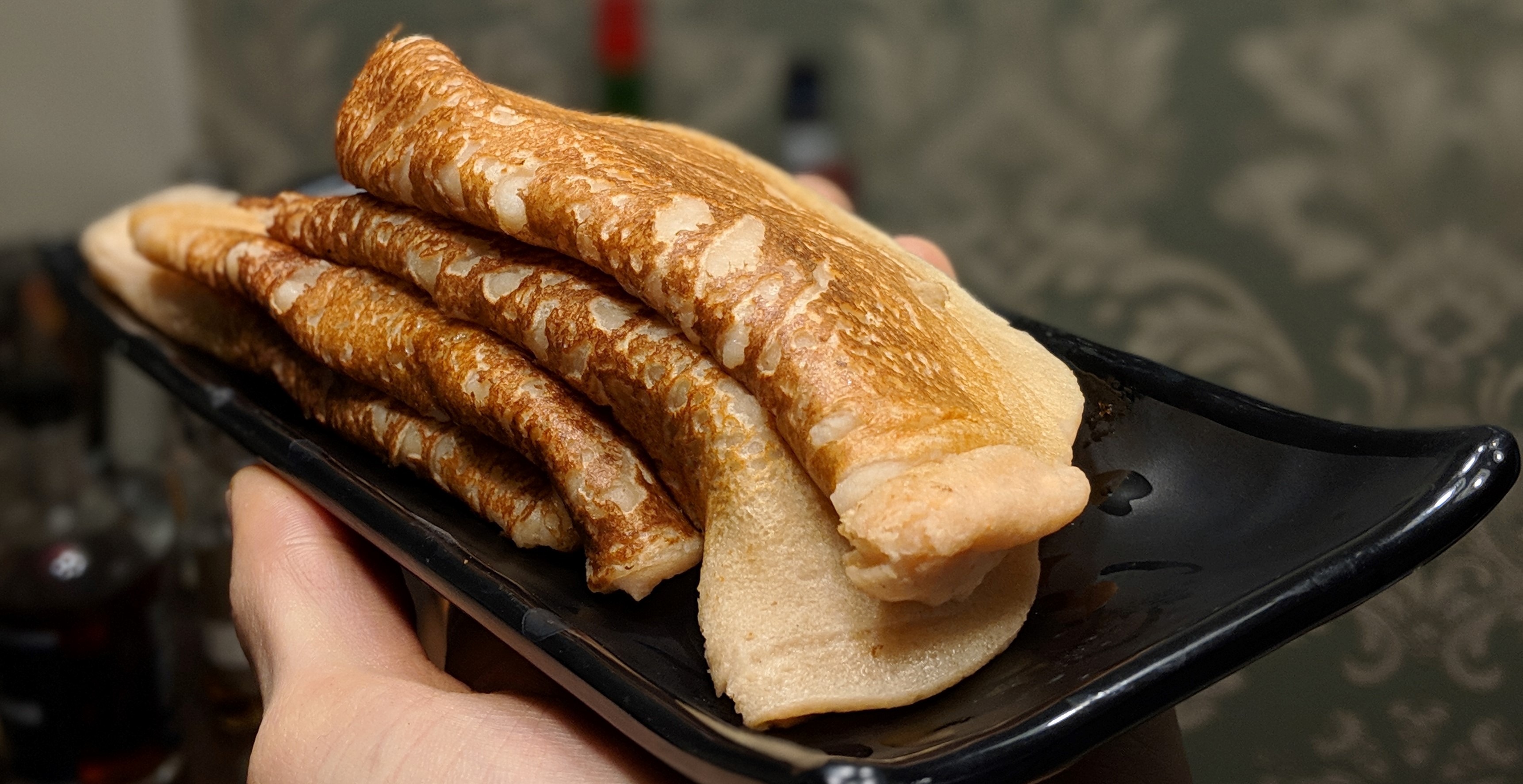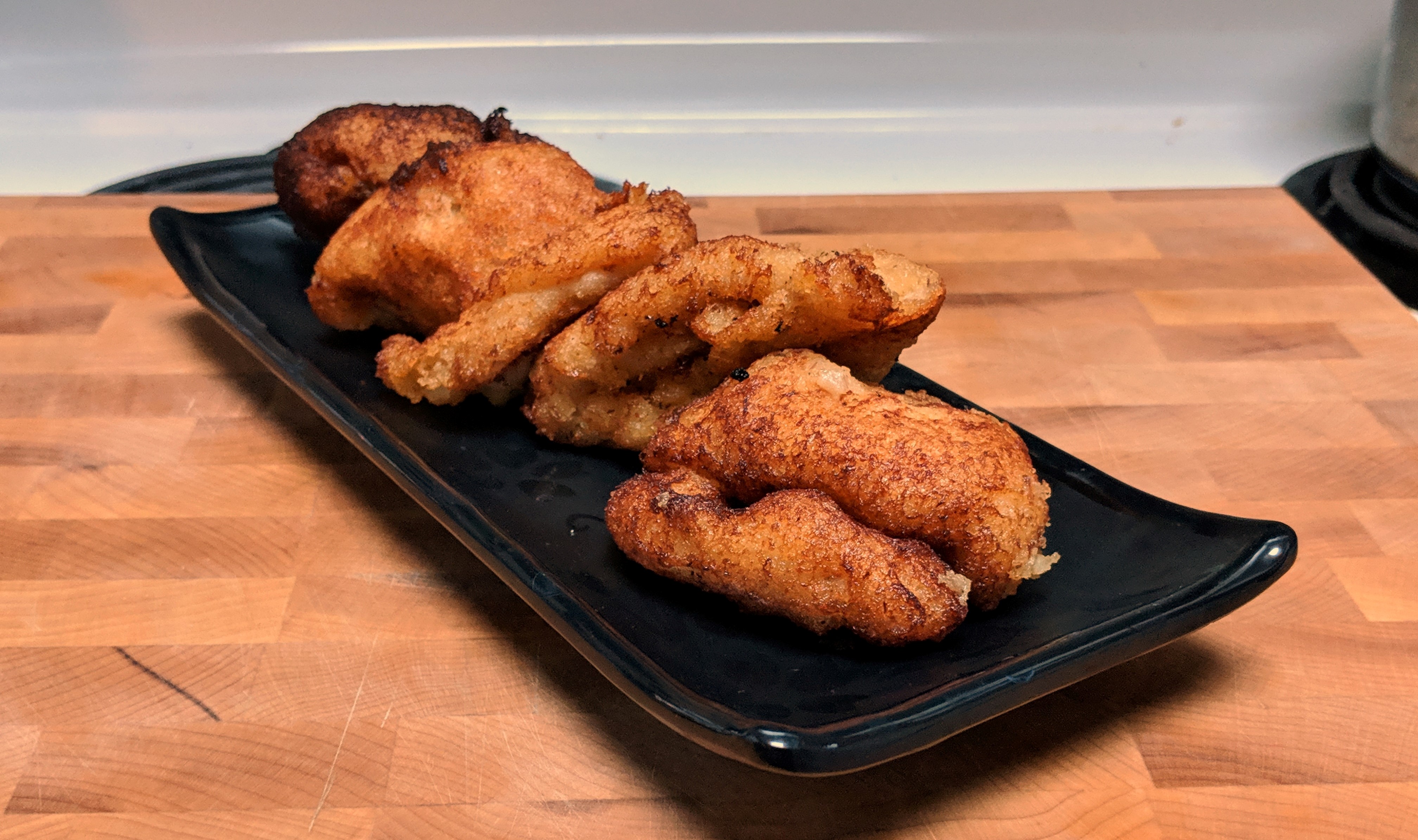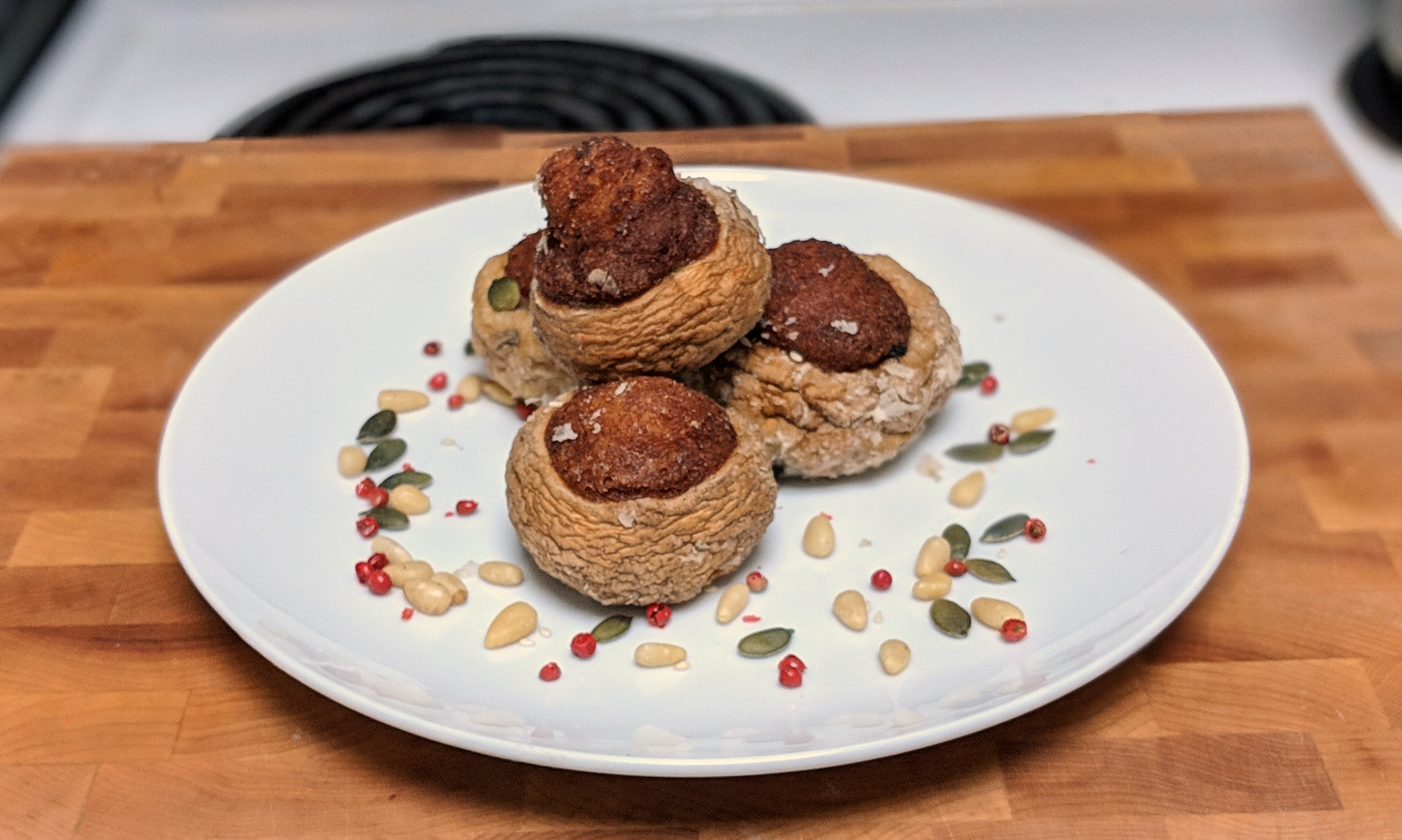Riffing on Acarajé
There’s a section in The Art of Fermentation where Sandor Katz describes a fried fritter found in Africa and Brazil called acarajé that was made out of a batter formed by fermenting a paste of black-eyed peas and onions. For whatever reason, the dish caught my fancy, so I decided to try riffing on the concept.
Iteration 1: Pancake of fermented canned black-eyed beans
Since I decided to try this a little last minute, I didn’t have enough time to do a proper soak, so I decided to start from canned black-eyed beans and only fermenting for a few hours. Although the resulting batter tasted good, the short ferment didn’t really allow the flavour to develop very much. Using black-eyed peas also reminded how much I hate hulling beans. Further, I had some issues working with the resulting batter, but that was mostly due to inexperience working with thin bean-based batters like this. All-in-all, this first iteration tasted decent, but was a bit annoying to prepare and underwhelming. Due to the disappointing result, I didn’t take a picture of this iteration.

Iteration 2: Fermented red lentil pancake
Ingredients
- 75g split red lentils
- 0.25 medium onion
- pinch of salt
- fermentation cultures (I used 1tsp of sauerkraut brine, 1tsp of gingerbug, and about half a tsp of 100% hydration sourdough starter)
- dechlorinated water
Process
- Soaked lentils overnight
- Blended together with onion, cultures, and enough water to make a blendable batter
- Left, covered, at room temperature to ferment for 12 hours
- Pre-heated well-seasoned cast iron pan with a bit of oil in it
- While pan is pre-heating, whip air into batter with an immersion blender
- Spread dollop of batter on pan as if making a thick crepe
- Flipped when the top of the pancake no longer looked like raw batter
Description
In order to avoid hulling beans, I decided to draw some inspiration from dosa and try switching from black-eyed beans to split red lentils for my next attempt. Since this was no longer a rush job, I was also able to soak the lentils overnight and blend them together in the morning with the onion, some salt, and just enough dechlorinated water for my blender to be able to blend the batter. In order to kick-start the ferment, I also added sauerkraut brine, ginger bug, and a small dollop of my sourdough starter.

Iteration 3: Fermented red lentil/adzuki bean fritter
Ingredients:
- 70g split red lentils
- 5g adzuki beans
- 0.25 medium onion
- pinch of salt
- fermentation cultures (I used 1tsp of sauerkraut brine, 1tsp of gingerbug, and about half a tsp of 100% hydration sourdough starter)
- dechlorinated water
Process
- Soaked lentils and beans for 6 hours
- Blended together with onion, cultures, and enough water to make a blendable batter
- Left, covered, at room temperature to ferment for 24 hours
- Heat up pot of oil
- Deep fry blobs in oil
- Dry and allow to cool
Discussion
Unfortunately, I ran out of split red lentils just shy of having 75g and didn’t want to go buy more, so this iteration also has 5g of adzuki beans. I soaked these for just 6 hours prior to blending with the quarter onion and cultures due to how the scheduling worked out. Otherwise, batter prep was the same as the previous iteration, but I left the batter to ferment for 24 hours instead of just 12.
My oil started out too hot, so my first couple fritters were a bit burnt on the outside, but the flavour was fantastic. The long fermentation gave them a pleasant sourdough-esque tartness and the classic lentil+onion combination is delicious to start with. These were amazingly good (I can see why Sandor Katz is a fan of longer fermentation times) and I think would be even better if they were served with some sort of rich sauce to provide a stronger counterpoint to the lactic acid notes, perhaps even something as simple as a mayonnaise drizzle.

Iteration 4: Soybeans with umami boosting
Ingredients
- 60g dry soybeans
- 60g onion
- 0.25 tsp tomato paste
- 0.5 tsp miso
- additional fermentation cultures (I used 1tsp of sauerkraut brine and 1tsp of gingerbug)
- dechlorinated water
Process
- Soaked soybeans for 8 hours then dehulled
- Blended together with onion, cultures, miso, and enough water to make a blendable batter
- Left, covered, at room temperature to ferment for 24 hours
- Whipped air into batter
- Attempted to deep fry
Discussion
As previously mentioned, I ran out of lentils, so I decided to try out the concept with soybeans I had left over from a failed attempt to make tempeh. I decided to drop the sourdough starter from the culture mix to make sure these hold together without the trace of gluten helping to bind them, and I added a bit of tomato paste and miso for added umami. The miso is also contributing some fermentation cultures of its own, although I’m not sure if they’ll be active enough to contribute much over a 24 hour ferment. Also, I was once again reminded of how much I hate hulling beans.
Unfortunately, this iteration had massive structural problems and wasn’t very cohesive in the pot. I tried whipping these manually instead of using an immersion blender as I had previously, but this turned out to be ineffective. While I cannot completely rule out some property of the soybeans as a confounding factor, I observed this same behaviour in iteration 5 prior to using the immersion blender.
Despite the structural difficulties, the ad hoc tofu sauce I whipped up for it was an excellent pairing that I think I shall carry forward. There’s no specific recipe for the sauce, but it consisted of tofu, white miso, mirin, sesame oil, and ume vinegar.

Iteration 5: Back to Lentils with Boosted Umami
Ingredients
- 75g dry red lentils
- 60g onion
- 1 small garlic clove (~5g)
- 0.25 tsp tomato paste
- 0.5 tsp miso
- additional fermentation cultures (for this iteration: 1tsp of gingerbug)
- dechlorinated water
- 0.25tsp baking soda
Process
- Soaked lentils for 8 hours then discarded water
- Blended together with onion, cultures, miso, and enough water to make a blendable batter
- Left, covered, at room temperature to ferment for 24 hours
- Whipped air into batter
- Deep fried fritters
Discussion
Now that I have restocked my lentil supply, I switched back to red lentils for this iteration. I also added a garlic clove as I felt that it would go nicely with the rest of the dish flavour-wise. In this iteration, I initially tried using manually whipped batter only to have the first fritter completely disintegrate in the pan. When I pulled out the immersion blender and whipped a bunch of air into the mix using that, the structural problems went away. While I’m sure a more patient person than me could make a manual process work, I think I am not going to bother with it any further. The immersion blender works and there’s no particular reason to seek out alternative methods.
I also tried adding a bit of baking soda to make the fritters airier and cut the sourness a touch. It definitely worked on both counts, perhaps a bit too well on the airiness, making these fritters almost hollow like funnel cakes. I think it was a good addition, but probably would be better at a slightly lower concentration - perhaps at half the concentration used here.
The sauce was again primarily composed of tofu and miso, which I found to be a pleasant pairing. I think something a bit richer would work a touch better though, but I haven’t decided on the nature of such a sauce. A cheese sauce would be nice, but, this dish is currently vegan and gluten free, so I’d rather avoid adding roux and dairy to it if I can avoid it. I might try doing some sort of tofu/nutritional yeast sauce to do a cheese-like thing, but I’m generally fairly hesitant to make substitute versions of things like cheese sauce. I was also thinking of doing something tahini based, which appeals to me a bit more to me than making a fake cheese sauce.

Iteration 6: Stuffed into Mushrooms
Discussion
This iteration used the same batter preparation as Iteration 5, although with half as much baking powder. I tried both parfrying the mushroom then adding the batter and frying the whole thing in one shot. I think the one-shot method is better, but neither was particularly excellent. Unfortunately, the surface of the batter fries way faster than the mushroom, so timing it so everything fries to proper doneness at the same time is, in my opinion, probably impossible. However, if the stuffed mushroom was instead parbaked then simply finished by frying, I think this problem could be solved. Unfortunately, my oven was occupied at the time with a loaf of sourdough, so I could not test this hypothesis. It might also be possible to use the batter as a coating instead of a filling, but I suspect it might be a bit too heavy for that and did not think to try it until after I was done.
All that said, the mushrooms did not have that much capacity for stuffing so I ended up with a lot of left over batter that I simply fried up as fritters. Once again, the fritters were delicious, so while there are some further avenues I could pursue in frying department, I think this is a case of it being better to just leave the dish alone. If they’re good as fritters, there’s no reason to try to force them into mushrooms.
Conclusion
Fermented lentil/onion batters are absolutely fantastic! For my cultures and temperatures, I think the ideal fermentation time would be around 18 hours, but 24 hours with a bit of baking soda to neutralize some of the acid makes for a solid result as well. If the plan is to make deep fried fritters, make sure to whip the batter well, otherwise it will fall apart in the oil. Since the fritter has a bit of a cutting acidity to it, it should go well with even the most extremely rich of sauces, so pairing a basic fritter with a slathering of something like a cheese or Hollandaise sauce would be a winning combination in my opinion.